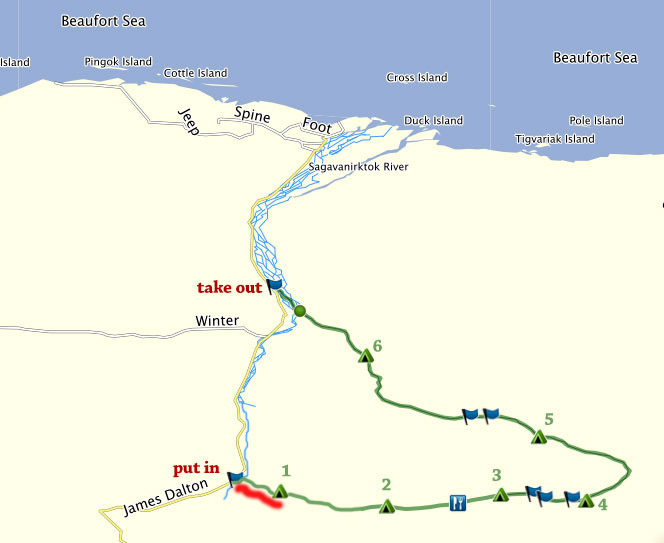Day 1, June 14, 2014, 7 miles backpacking the Ribdon River
One river crossing in a packraft (Sagavanirktok)
Describing my 7 day, 170 mile wilderness backpack and packraft trip along the Ribdon, Ivishak and Sagavanirktok rivers in Alaska’s Brooks Range from June 14-20.
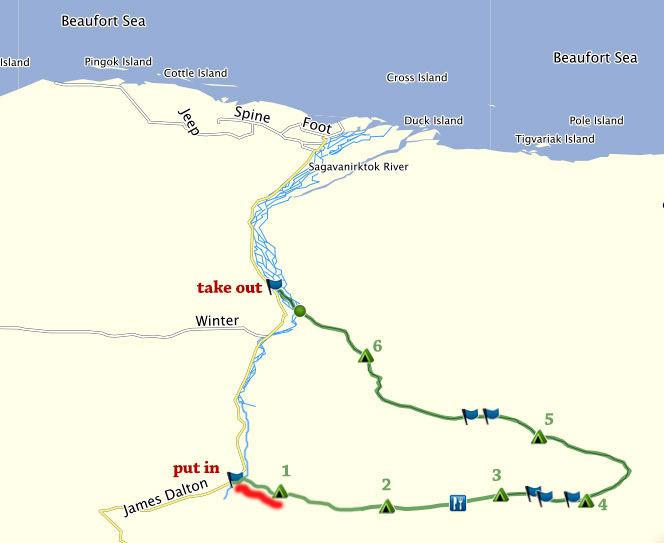
Day one: Route Map – hike up the Ribdon river valley, Packraft down the Ivishak river. 3.5 days hiking, 3.5 days on the river.
As a preamble, let me reiterate that I’m a beginner in the “light and fast” wilderness travel trips with a Packraft (for those uninitiated to the Packraft, it is a small, lightweight, raft, that can be deflated and packed away in a backpack). Normally, I would spend more time to cover this amount of mileage, but due to our schedule constraints, we only had a week. And, there was a lure in pushing ourselves physically to see if we could truly travel light (relatively) and fast. This sojourn was both a great adventure and a good learning experience. It fits right inside the excellent book I’ve been reading through, and meditating on, for a few months now. The book is titled: The Laws of Simplicity by John Maeda. As his first point states: “The easiest way to achieve simplicity is through thoughtful reduction”. And so goes the packing process for a trip like this. You get rid of absolutely everything you do not need through a thoughtful reduction process, but you make sure you have everything you do need–and the lightest possible items. So with that process largely behind me, I departed for Alaska’s North Slope to photograph a few days before the packraft trip began.
On the drive up the Dalton Highway, I encountered a snowstorm at the top of Atigun Pass (Alaska’s highest roadway pass through the continental divide of the Brooks Range, 4,738′ (1,444 m). Take a look at this bicycle rider. I chatted him up for a minute to make sure all was o.k. Alaska in the summer…hmmm.
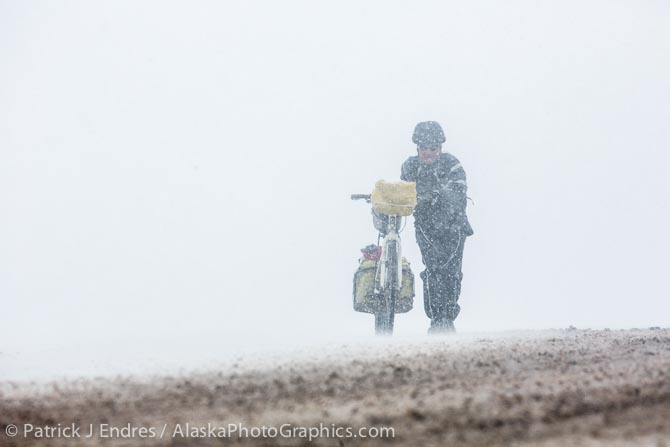
Bicycle rider in Atigun Pass during a snowstorm. June 12, 2014.
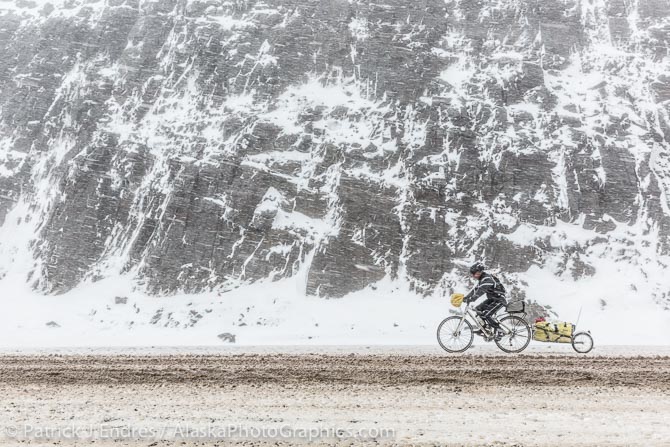
Bicycle rider in Atigun Pass during a snowstorm. June 12, 2014.
It was a late, wet spring in the north and when I glanced across the first river crossing we were to make at the very start of our trip, it was raining, windy and cold. The roiling and sloppy waves of the Sagavanirktok river (our first crossing) were gray and brown and moving very fast due to the recent rain. The weather and river conditions made me a little nervous. But being a little bit nervous is part of every Arctic backcountry venture I’ve been on. There is something about pushing yourself a little bit that delivers the commensurate rewards of a successful trip. I’ve never been fond of a “paint-by-number-life” and this would be a good little piece of adventure artwork to add to the portfolio of life experiences. After crossing the Sag river, we would hike about 60 miles inland, then paddle 120 miles down the Ivishak river which makes its confluence with the Sag river about 60 miles north of our put in spot on the Dalton Highway. That would be our take out spot where the Sagavanirktok River comes near the highway again. My friend Mark was going to meet me there in a few days, and we would leave one vehicle at the takeout and shuttle back to the put in location.
Day 1, June 14, 2014, 7 miles
Backpacking the Ribdon River valley
As it turned out, the weather finally cleared over the next few days, and when Mark and I finally met and shuttled to our put in location, the sunny weather was a cheerful bonus for our launch day. At 4 p.m., we made the final few tweaks (finally!) to our loaded backpacks and were incredibly jazzed to finally put this thing into motion. We hiked just a short distance from the vehicle and found a suitable place to cross the river, so we blew up the packrafts, took a happy snap, and jumped in.
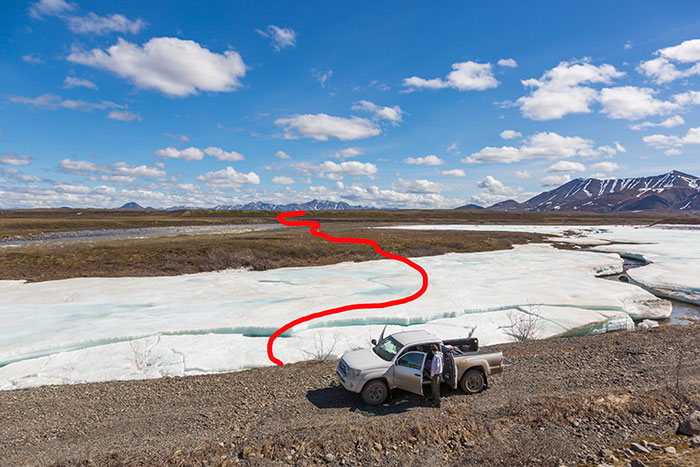
Our route from the put in location, across the Sag river, and starting up the Ribdon River valley.
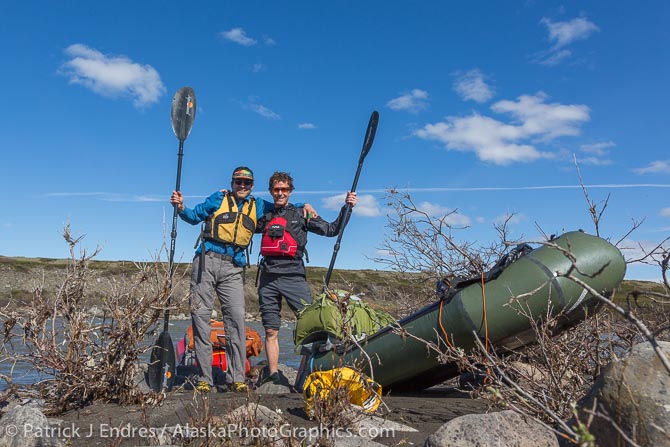
Mark and I at the start of our trip, just before crossing the Sag river. Awesome sunny day to greet us for day 1!
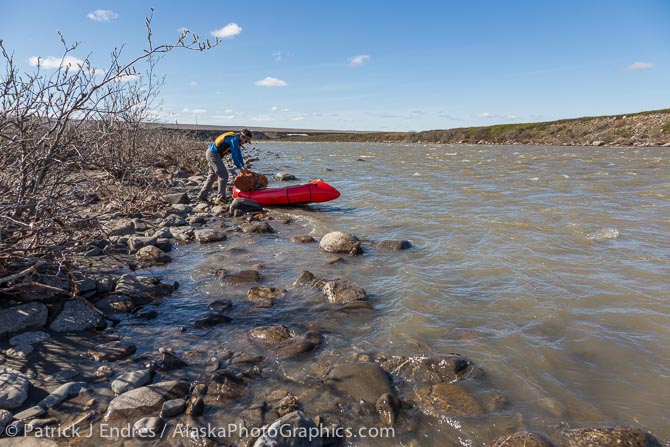
Crossing the Sag river at the start of the trip. Canon 5D Mark III, 24-105mm f/4L
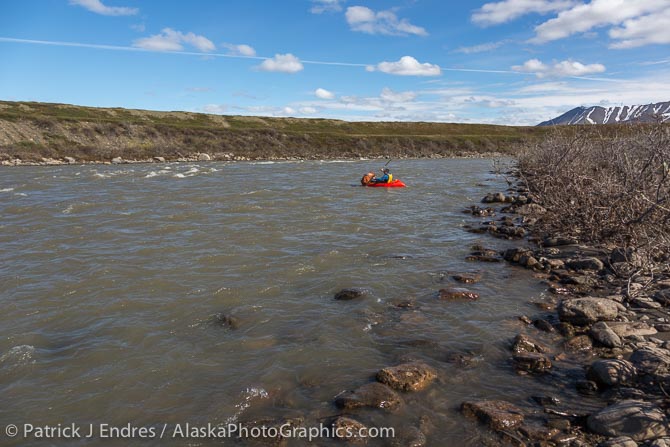
Crossing the Sag river at the start of the trip. Canon 5D Mark III, 24-105mm f/4L
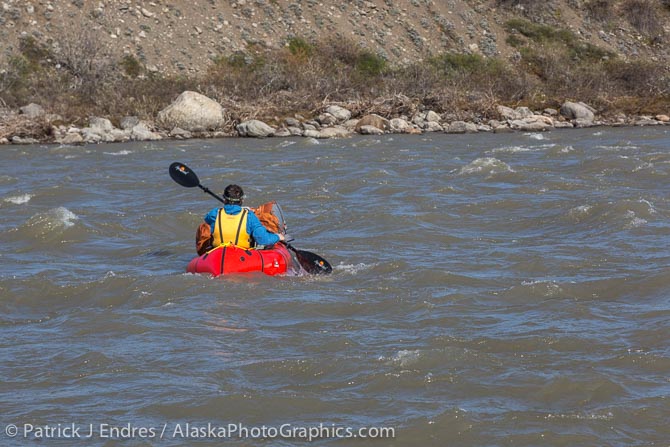
Crossing the Sag river at the start of the trip. Canon 5D Mark III, 24-105mm f/4L
In retrospect, the river crossing was pretty simple and benign. On the other side, we repacked the boats, threw on the backpacks and headed across the tundra. My pack came in at about 55 pounds (25k) with water. I weigh 133 pounds (60k) so that is 41% of my body weight. This is why the first law of simplicity is so important. Since we started late in the day, we hiked across the tundra about 7 miles and set up camp on a pleasant alpine ridge, with a view of the river valley.
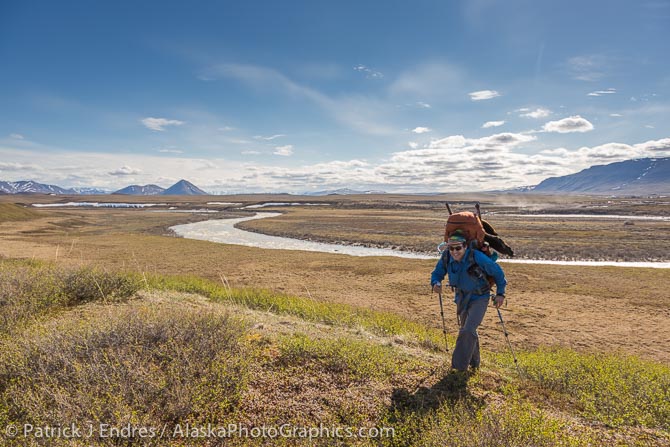
Looking back on the Sag river.
The hiking was in general pretty good, but we crossed a number of small drainages and slogged through some wet, spongy tundra. This is where the lightweight, drainable shoes came in handy, however, that water was cold! And cold, wet feet, for a prolonged time, start to get tingly and numb. So the following day, I pulled out my seal socks (waterproof socks) and hiked in those instead. That made a big difference in keeping the feet a little warmer. Mark suggested that turkey basting bags are a good and cheap alternative to this.
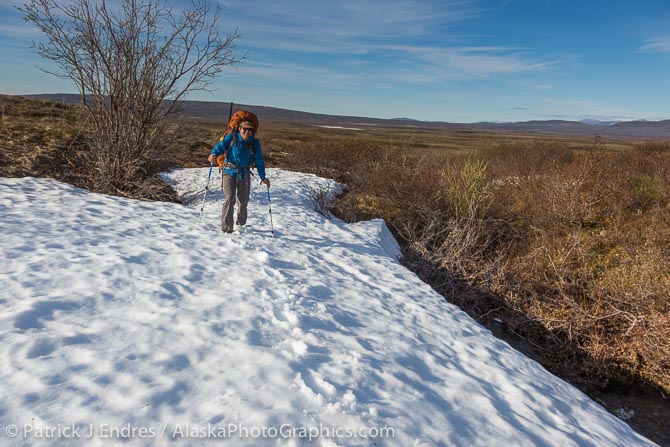
Remnant snow remained in shadowed slopes.
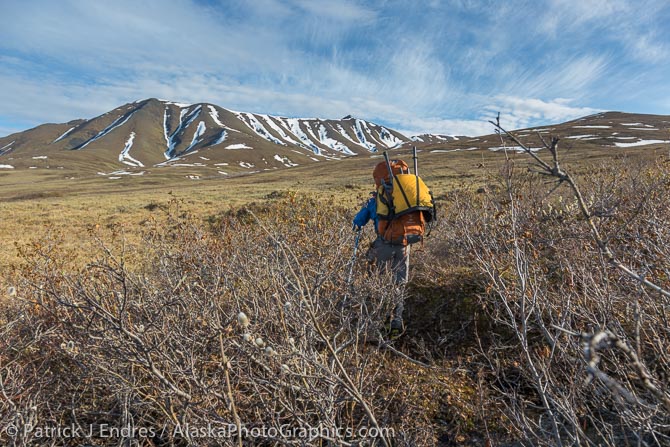
We crossed many little drainages as the mountains drained into the Ribdon River.
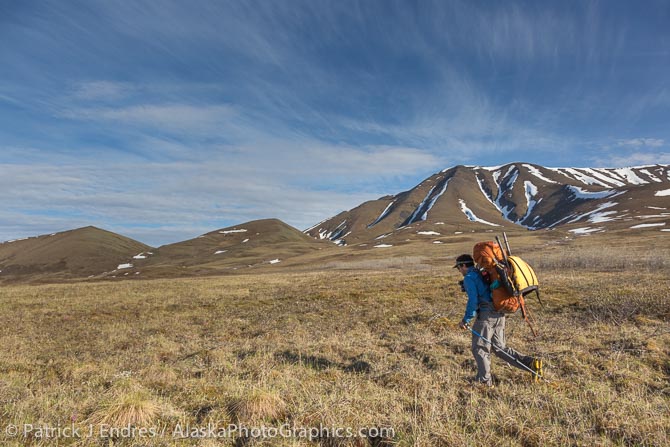
Trekking across the tundra. Some wet and spongy slogging, but in general, pretty good walking.
If you have hiked in the Alaska mountains in spring, you would have recognized the cast of characters growing on the tundra. Mountain aven, wind flower, glacier aven, wooly lousewort, and so on–the early bloomers.
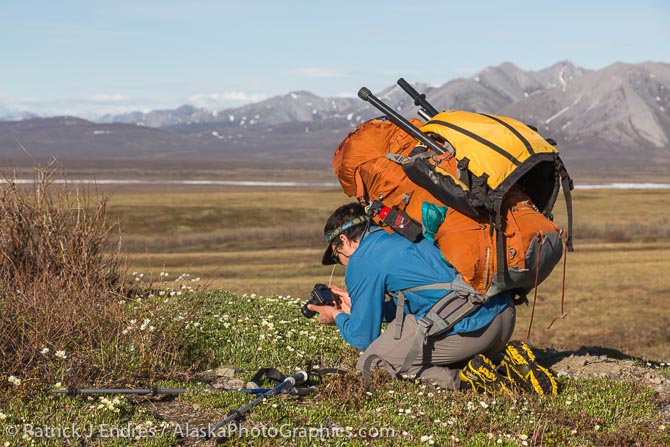
Tundra wildflowers.
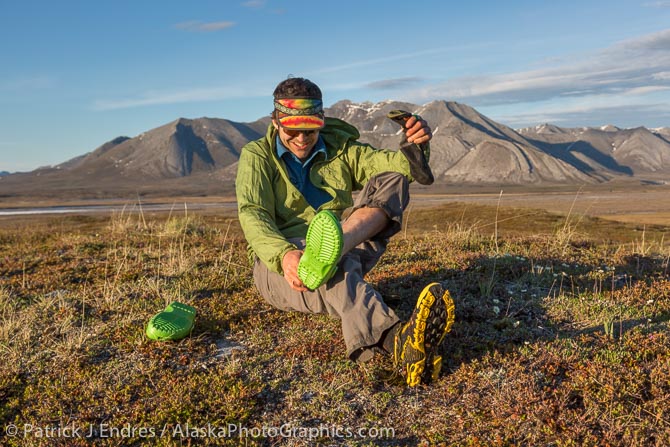
Crocks are a great, lightweight shoe to change into after a day of hiking in wet feet.
The mosquitoes were not too bad on day one, although they were just awakening. The never setting sun in Alaska’s Arctic painted the hills a warm golden color.
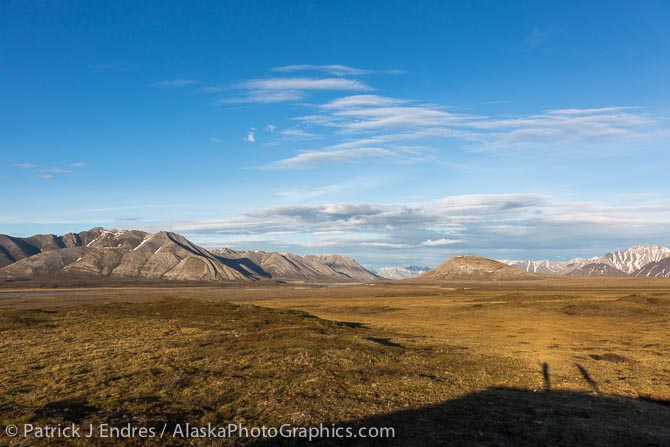
Shadows of the midnight sun, Camp #1
We both had some leftover food from our journey up the road so we finished that off instead of cooking a hot meal. The value of hot meals would become very apparent and important later in the trip. But, I was quite anxious to start diminishing the weight of that pack by consuming the food inside.
My general M/O when tent camping in bear country is to have an air horn with me inside the tent, along with some reporting bear crackers. Just outside the tent zipper sits a can of pepper spray. And for the record, I know exactly what it is like to have pepper spray go off inside a tent! When possible, I try to cook at a different location than the camp spot, although this is not always possible. We would see our first grizzly bear on day #2.
Soon after I was in the tent, I realized one thing that I forgot to do. My brand new NeoAir thermarest is slippery as could be, and I forgot to apply a little material to make it slide less. And, the Tarptent Squall we were using had a super slippery floor. Modifications list for the next excursion begins. This list will grow as the trip progresses. A happy, deep sleep soon ensued and I was glad I chose my medium weight down sleeping bag instead of the super light version!

